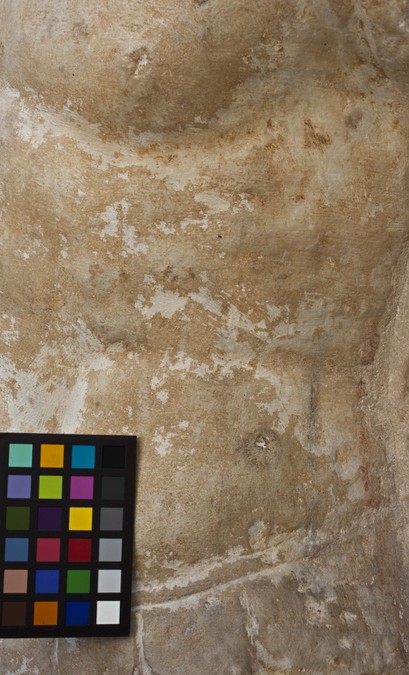Warrior relief
Summary
This relief has only briefly been examined. Traces of red, black and blue are found. The blue traces observed on the background have been identified as Egyptian blue by means of VIL- imaging. XRF was performed on the red and black and showed a content of iron and lead respectively.
Description of object
The relief has been severely damaged and consists of more than 4 large fragments put together. The indication of the pupil in the right eye mentioned by Clairmont is no longer visible.
Parts of the surface of the sculpture have been rasped, which is clearly apparent on the cuirass, unlike the face and the neck which have a smooth, polished surface.
Remnants of biological growth and incrustation are observed in several places and the main part af the relief bears an orange patina.
Choice of methods
Visual examination
- Macroscopic
- Microscopic in situ
Technical imaging
- VIL
Sampling
- XRF
Visual examination
Red at the lower part of the chiton, on the button on the left shoulder and in the right iris. Red and black vertical lines on the left side of the cuirass. Small traces of blue on the background of the relief.
Technical imaging
VIL: The background shows spatially the presence of luminescent particles. The scattered grains shining bright white indicate the use of Egyptian blue.
Other types of investigation
XRF: XRF analysis was performed on the red and black vertical lines on the cuirass. The result on the red colour showed a content of iron (Fe), indicating the use of hematite iron oxide while the black colour showed a content of lead (Pb).
Bibliography
M. Moltesen (1995), Catalogue. Greece in the Classical Period. Ny Carlsberg Glyptotek, Copenhagen, 104-105, cat. no. 45.
- IN 1508
- Relief
- c. 330 B.C.E.
- Classical
- Marble
- Acquired in 1896 in Athens.
- H. 146 cm.; W. 56 cm., D. 39 cm.






